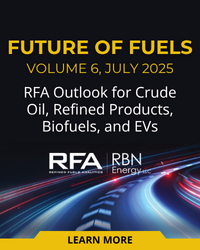Although California refineries initially met the criteria that spurred development of crude-by-rail (CBR) shipments to other coastal regions (lack of pipeline infrastructure and wide crude price differentials between stranded inland supplies and coastal alternatives) neither rail shipments or terminal build outs have made much of a dent in the Golden States’ crude supply. At their height in December 2013 CBR shipments into California reached 36 Mb/d – just 2% of the State’s 1.9 MMb/d refining capacity and they have since dwindled to a trickle. Today we examine the low pace of shipments.
Recap
This is Part 7 in our series updating the sorry state of the CBR business in North America in 2016 compared to its heyday a few years back. In Part 1 of this series we noted CBR declines in response to narrower spreads between U.S. domestic crude benchmark WTI and international equivalent Brent. The lower spreads reduce the incentive to move crude from inland basins to coastal refineries by rail because the latter is a more expensive transport option compared to pipelines. CBR became a big deal when WTI was discounted to Brent by upwards of $25/Bbl in 2011 and 2012 because of congestion caused by a lack of pipeline capacity. Back then it made sense to use rail to get stranded crude to market. As a result, U.S. CBR shipments grew from 33 Mb/d in January 2010 to a peak of 928 Mb/d in October 2014 (according to Energy Information Administration - EIA). As new pipelines have been built out to provide less expensive options to get stranded crude to market so the WTI discount has narrowed and CBR traffic has declined. Primarily in response to the narrowing spread – overall CBR volumes fell during 2015 but not as fast as you might expect – dropping only 30% between January and December 2015 (latest EIA data) even though spot market economics for rail shipments often made no sense. As we discussed in Part 2 – looking at the epicenter of the CBR boom in North Dakota – the slower than expected decline in rail shipments is mostly because committed shippers and refiners continue to use rail infrastructure that they invested in (and made take-or-pay commitments to) and because some routes do not have pipeline access (East Coast and West Coast).
In Part 3 we looked at CBR traffic out of the Niobrara shale region in the Rockies. Midstream companies continue the build out and expansion of rail terminals as well as new pipelines in this region even though production has leveled off. In Part 4 we looked at the fate of CBR load terminals in Western Canada that are “overbuilt and underutilized”. In Part 5 we turned to CBR market destinations – beginning with the East Coast. In Part 6 we began a two-part look at CBR unloading on the West Coast with the Northwest refineries. Those refineries continue to receive fairly significant shipments of CBR from North Dakota in the face of narrowing spreads between West Coast benchmark Alaskan North Slope (ANS) and WTI – in part because Washington refiners are committed to term throughput contracts and railcar leases. This time we complete our West Coast review with a look at California CBR traffic and terminals.
Join Backstage Pass to Read Full Article










